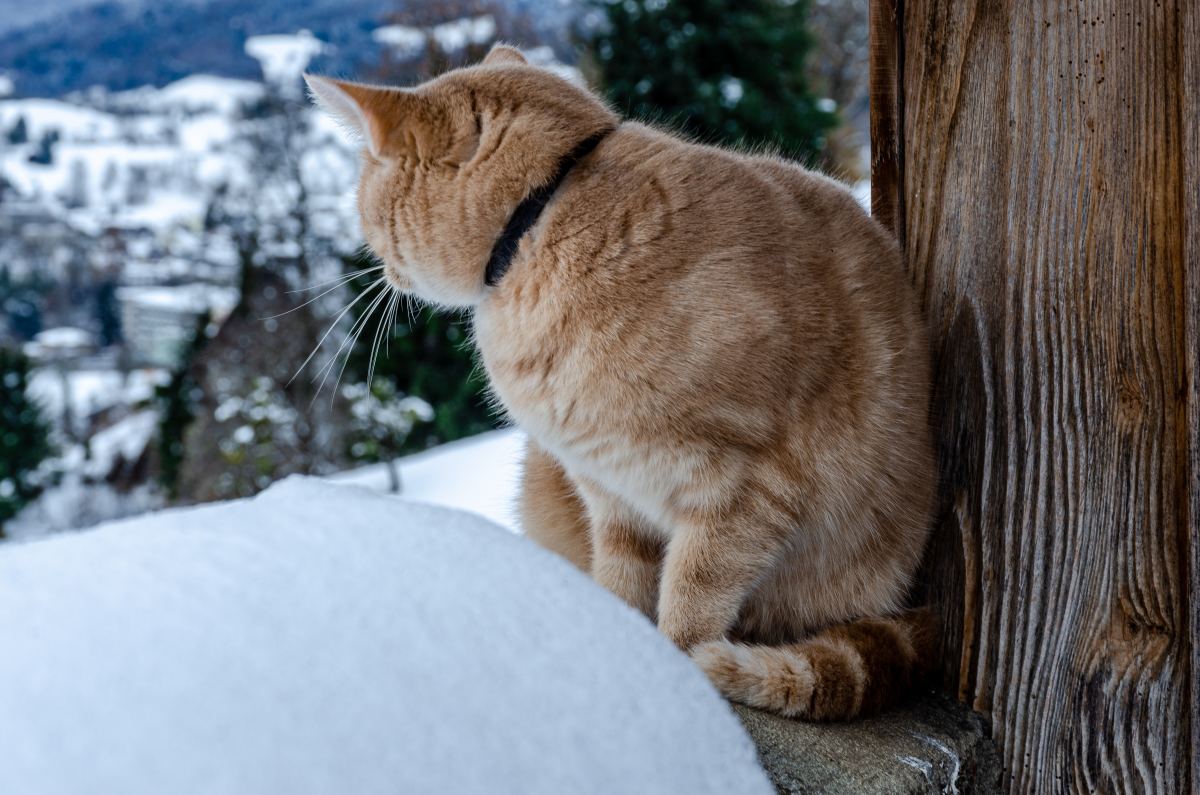Home>Health & Nutrition>Cats’ Temperature Tolerance: What You Need To Know


Health & Nutrition
Cats’ Temperature Tolerance: What You Need To Know
Published: February 19, 2024
Learn how to ensure your cat's health and nutrition by understanding their temperature tolerance. Find out what you need to know to keep your feline friend happy and healthy.
(Many of the links in this article redirect to a specific reviewed product. Your purchase of these products through affiliate links helps to generate commission for Temperatures.com, at no extra cost. Learn more)
Table of Contents
Understanding Cats' Natural Temperature Range
Cats are known for their adaptability to various temperatures, but it's essential to understand their natural temperature range to ensure their well-being. Unlike humans, cats have a higher body temperature, typically ranging between 100.5°F and 102.5°F. This higher baseline temperature is a result of their unique physiology and metabolism.
Cats are designed to thrive in moderately warm environments, as their bodies are naturally equipped to handle higher temperatures. Their fur acts as insulation, providing warmth in cooler conditions and offering protection from the sun's heat. Additionally, cats have sweat glands on their paw pads, which aid in cooling their bodies through evaporation.
In colder temperatures, cats can regulate their body heat by curling up to conserve warmth or seeking out cozy spots for rest. Their ability to adjust to colder environments is attributed to their fur, which traps heat close to their bodies, and their natural inclination to seek shelter in warm, enclosed spaces.
Understanding a cat's natural temperature range is crucial for providing appropriate care and ensuring their comfort in various weather conditions. By recognizing their inherent ability to adapt to different temperatures, pet owners can make informed decisions to support their feline companions' well-being.
Factors Affecting Cats' Temperature Tolerance
Coat Length and Color
The length and color of a cat's coat play a significant role in their temperature tolerance. Cats with longer, thicker coats are better equipped to handle colder temperatures due to the insulating properties of their fur. Conversely, short-haired cats may be more sensitive to chilly conditions. Additionally, the color of a cat's coat can impact their heat tolerance. Dark-colored cats absorb more heat from the sun, making them more susceptible to overheating in hot weather.
Age and Health Status
A cat's age and health status are crucial factors in determining their temperature tolerance. Kittens and senior cats are generally more sensitive to extreme temperatures. Kittens have yet to fully develop their ability to regulate body temperature, while older cats may have diminished thermoregulatory functions. Furthermore, cats with underlying health issues, such as respiratory or cardiovascular conditions, may struggle to cope with temperature extremes.
Hydration and Access to Water
Proper hydration is essential for regulating a cat's body temperature. In hot weather, cats need access to fresh water to prevent dehydration and maintain their internal cooling mechanisms. Dehydration can significantly reduce a cat's ability to tolerate heat, making it vital for pet owners to ensure that their feline companions have constant access to clean water, especially during warmer months.
Environmental Conditions
The environmental conditions in which a cat resides greatly influence their temperature tolerance. Factors such as humidity, air circulation, and access to shade can impact a cat's comfort level. High humidity can hinder a cat's ability to cool down through evaporation, while poor air circulation can exacerbate heat retention. Providing ample shade and ventilation in the living environment is crucial for helping cats regulate their body temperature effectively.
Breed and Genetic Factors
Certain cat breeds are inherently better adapted to specific temperature ranges. Breeds originating from colder climates may have thicker coats and a higher tolerance for lower temperatures, while breeds from warmer regions may be more heat-tolerant. Additionally, genetic factors can influence a cat's thermoregulatory abilities, impacting their overall tolerance to temperature fluctuations.
Understanding the various factors that affect a cat's temperature tolerance is essential for providing optimal care and ensuring their well-being in diverse weather conditions. By considering these elements, pet owners can take proactive measures to support their feline companions' comfort and health.
Signs of Overheating in Cats
Recognizing the signs of overheating in cats is crucial for preventing heat-related health issues. Cats are susceptible to overheating, especially in hot and humid conditions. It's essential for pet owners to be vigilant and attentive to their feline companions' behavior, as early detection of overheating symptoms can prevent serious complications.
Excessive Panting and Drooling
When a cat is overheating, they may exhibit excessive panting and drooling. Panting is a natural mechanism for cats to regulate their body temperature, but when it becomes rapid and prolonged, it indicates that the cat is struggling to cool down. Excessive drooling may also accompany panting as the cat attempts to dissipate heat through saliva.
Read more: Peru’s Climate: What You Need To Know
Lethargy and Weakness
Overheated cats often display signs of lethargy and weakness. They may appear unusually tired, sluggish, or unresponsive to stimuli. Lethargy is a common indicator of heat stress in cats, as their bodies divert energy to cope with the elevated temperature, leading to a noticeable decrease in activity levels.
Elevated Body Temperature
A cat's normal body temperature ranges between 100.5°F and 102.5°F. When a cat is overheating, their body temperature may rise above this range. While measuring a cat's temperature at home can be challenging, a cat exhibiting other signs of overheating alongside a warm or hot body to the touch should prompt immediate attention.
Reddened Gums and Tongue
Overheating can cause a cat's gums and tongue to become red or even bluish in severe cases. This discoloration is a result of the body's attempt to dissipate heat, leading to increased blood flow to these areas. Reddened gums and tongue are clear indicators of heat stress and require prompt intervention.
Vomiting and Diarrhea
In extreme cases of overheating, cats may experience vomiting and diarrhea. These symptoms are the body's way of expelling toxins and attempting to cool down. Vomiting and diarrhea in conjunction with other signs of overheating necessitate immediate veterinary attention to address the underlying heat-related issues.
Seeking Cool Surfaces
When cats feel overheated, they instinctively seek out cooler surfaces to alleviate their discomfort. This behavior may involve lying on tile floors, seeking out shaded areas, or attempting to find relief near air vents or fans. Observing a cat's preference for cooler spots can provide valuable insight into their need for temperature regulation.
Agitation and Restlessness
Overheated cats may exhibit signs of agitation and restlessness. They may appear anxious, fidgety, or unable to settle down. This behavior stems from their discomfort and the body's attempt to find relief from the elevated temperature.
Rapid Heart Rate and Breathing
An elevated heart rate and rapid breathing are physiological responses to overheating in cats. Monitoring a cat's heart rate and breathing patterns can provide valuable information about their heat stress levels. A significantly increased heart rate and shallow, rapid breathing are clear indicators of overheating.
Loss of Appetite
Overheated cats may lose their appetite due to the stress on their bodies. A noticeable decrease in food intake, especially in conjunction with other signs of overheating, warrants immediate attention to address the underlying heat-related issues.
Collapse or Seizures
In severe cases of overheating, cats may experience collapse or seizures. These are critical indicators of heatstroke and require immediate emergency veterinary care. Collapse or seizures are life-threatening manifestations of severe heat stress and should be treated as medical emergencies.
Understanding these signs of overheating in cats empowers pet owners to take proactive measures to prevent heat-related complications. By remaining vigilant and responsive to their feline companions' well-being, pet owners can ensure a safe and comfortable environment for their cats, especially during periods of elevated temperatures.
Tips for Keeping Cats Comfortable in Extreme Temperatures
-
Provide Ample Hydration: Ensure that your cat has access to fresh, clean water at all times, especially during hot weather. Consider placing multiple water bowls in different areas of your home to encourage regular hydration.
-
Create Cooling Stations: Set up designated cooling areas for your cat, such as tiled surfaces or cooling mats, where they can seek relief from the heat. Additionally, placing frozen water bottles wrapped in towels in these areas can provide extra cooling comfort.
-
Shade and Ventilation: Create shaded areas in your home and outdoor spaces where your cat can retreat from direct sunlight. Ensure proper ventilation to promote air circulation, aiding in temperature regulation.
-
Grooming and Coat Care: Regular grooming helps manage your cat's coat during extreme temperatures. Brushing removes loose fur and prevents matting, allowing for better air circulation and heat dissipation.
-
Indoor Environment: Keep indoor temperatures moderate and consistent, especially during heatwaves. Use fans or air conditioning to maintain a comfortable indoor climate for your cat.
-
Limit Outdoor Exposure: During peak heat hours, limit your cat's outdoor activities to early mornings or evenings when temperatures are lower. This reduces their risk of overheating and sunburn.
-
Frozen Treats: Offer frozen treats, such as ice cubes or specially formulated cat ice cream, to help cool down your cat from the inside out. These treats provide a refreshing way for your cat to stay hydrated and comfortable.
-
Monitoring Behavior: Pay close attention to your cat's behavior in extreme temperatures. Look for signs of discomfort or overheating, and take prompt action to provide relief and prevent potential heat-related issues.
-
Emergency Preparedness: Familiarize yourself with the signs of heatstroke in cats and have a plan in place for emergency care. Knowing the nearest veterinary clinic's contact information and location can be crucial in critical situations.
-
Consult with a Veterinarian: If you have concerns about your cat's ability to tolerate extreme temperatures, seek guidance from a veterinarian. They can provide tailored advice based on your cat's specific health and needs.
By implementing these tips, pet owners can effectively support their cats' well-being and comfort during periods of extreme temperatures. Prioritizing proactive measures and attentive care can help mitigate the potential risks associated with temperature fluctuations, ensuring a safe and comfortable environment for feline companions.











